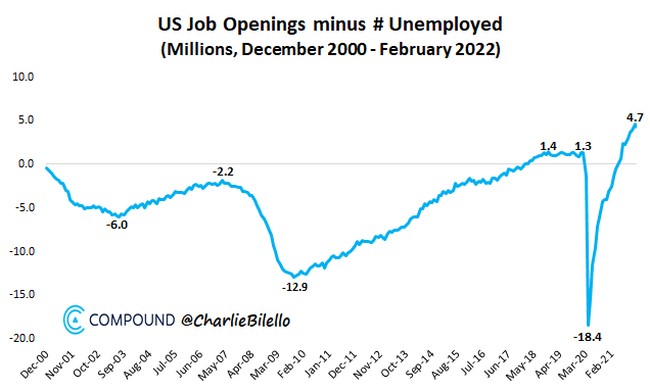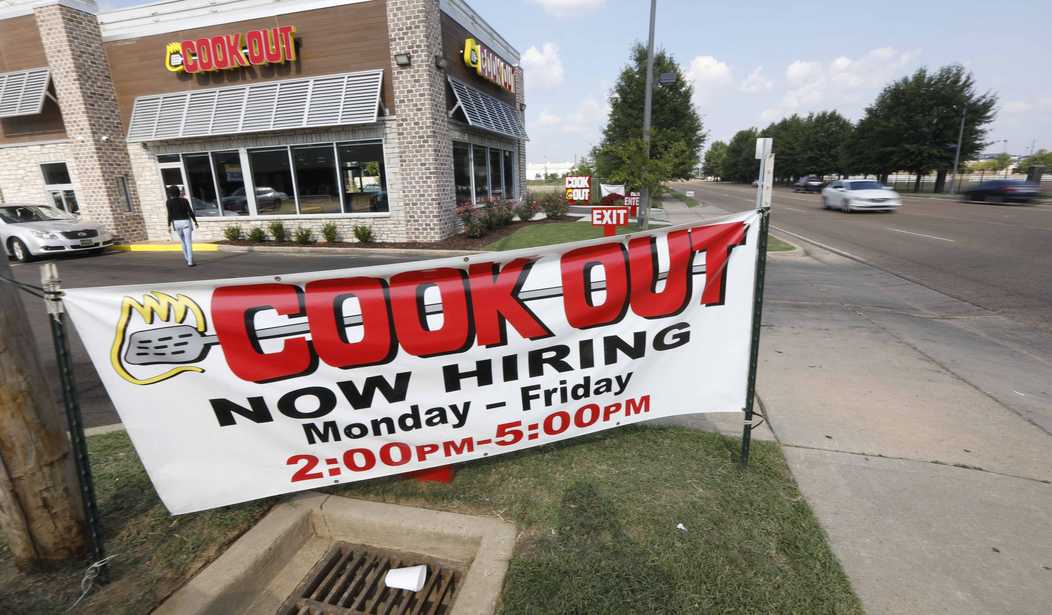It’s easy to hear news about the low unemployment rate — 3.8% at the time of writing this article — and wonder why we’re still seeing so many “now hiring” signs at places like fast-food restaurants and other aspects of the service industry. After all, if so many people have jobs, why are companies still desperately searching for employees?
Low unemployment and what seems like a ton of employment opportunities aren’t making it any easier to get a burger or to see fully stocked shelves (on top of supply chain issues, retail stores are having trouble finding employees to do the grunt work). I’ve seen signs at fast-food joints offering bonuses to increasingly younger teens.
What’s astonishing about this post-pandemic job outlook is that there are still 4.7 million more jobs than there are people looking for jobs. For starters, those who want to find work are finding it.
“Private sector payrolls … are nearly back to pre-pandemic levels (600k away) while total nonfarm payrolls … are approaching their prior highs as well (2.1 million away),” Charlie Bilello points out at Compound. “The good news: there are still over 10.9 million job openings in the US, which is 4.7 million higher than the number of unemployed persons, a record spread.”

Yes, that’s a record. And yes, it’s painfully clear that many of these jobs are entry-level positions and in service industries. If you have a teen who wants to work, there’s probably never been a better time for him or her to find a nicely-paying job.
It’s worth looking at the labor participation rate. As of February, the civilian labor force participation rate sits at 62.3%, and it has been steadily on the rise since the country reopened after COVID-19 lockdowns. It’s still a far cry from the Jan. 2007 peak of 66.4% labor force participation.
There’s no single reason for this trend, but it’s something we’ve seen brewing for months now. When the government threw more and more unemployment benefits at people, it’s true that many people stayed out of work because it was more lucrative to rake in that government cash than it was to work. Some people actually never went back to work based on their fear of the virus as well.
Related: Biden’s Economic Misery Index Creeps Ever Upwards
Back in November, I wrote about the phenomenon that came about as a result of reopening businesses after the lockdowns and which took the nickname “the Great Resignation.”
“Many people have left their jobs for better opportunities,” I said at the time. “Remote work, higher pay, and benefits can lead people to make a change. The increase in job openings as some states have finally reopened after last year’s pandemic closures has led many employees to leave lower-paying jobs for positions that offer more money and better options.”
The fact that so many job openings remain means that there’s still room for people to find new opportunities to seek better conditions and new ventures. We may see even more waves of resignations as employees seek out bigger and better shots to further their careers.
We’ve seen working parents discover that they can make do with less money and have one parent at home to take care of the kids. Oftentimes, daycare eats up way too much of that second paycheck, so the pandemic caused some parents to realize how well they could get by without it. Back in 2020, CNN reported on the beginnings of this trend with a headline that presciently said that the U.S. “job market may never be the same.”
Additionally, some parents saw for the first time what their kids were learning in school. Everybody being home during the pandemic exposed, during remote learning, the tripe that some public school districts foisted upon unsuspecting families. It not only led to the parenting revolution we’ve seen lately, but it also drove some of these job-quitting parents to homeschool their kids, not just in the U.S. but abroad as well. (This is despite the Seattle Times warning parents not to stay home to teach their own kids — as if concerned parents are going to listen to them.)
Another fascinating feature of our current employment situation is that many people have quit working traditional jobs to start their own businesses or join the “gig economy.” As of 2020, over 51 million Americans engaged in some level of full- or part-time freelance work, and that number continues to grow. The Bureau of Labor Statistics admits that it’s hard to count “gig” employees among employment stats, though they try. But the lure of freelancing is part of the reason for so many job openings in the traditional marketplace today.
The employment picture in this country is complex. This mixture of factors tells the tale of why we can simultaneously see a low unemployment rate side by side with millions of unfilled job openings. One thing’s for sure, though — we know that anytime we see someone from the Biden administration tout “job creation,” we can see right through it.
Our economy created over 6.5 million new jobs last year—more jobs created in one year than ever before in the history of America.
We are building a better America.
— Kamala Harris (@KamalaHarris) March 5, 2022
Those jobs were already there — this administration’s policies didn’t do a thing to “build a better America.”
Another thing this job situation should do for us is give us more patience when we have to wait a little longer than normal to get our tacos. They’re doing the best they can with the staff they have, so let’s give ’em a little grace.










Join the conversation as a VIP Member